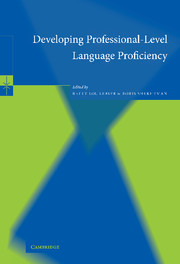Book contents
- Frontmatter
- Contents
- Notes on contributors
- Foreword
- Acknowledgments
- I Principles, practices, and theory
- II Programs
- III Learners and users
- 12 Understanding the learner at the Superior–Distinguished threshold
- 13 Preliminary qualitative findings from a study of the processes leading to the Advanced Professional Proficiency Level (ILR 4)
- References
- Index
12 - Understanding the learner at the Superior–Distinguished threshold
Published online by Cambridge University Press: 03 December 2009
- Frontmatter
- Contents
- Notes on contributors
- Foreword
- Acknowledgments
- I Principles, practices, and theory
- II Programs
- III Learners and users
- 12 Understanding the learner at the Superior–Distinguished threshold
- 13 Preliminary qualitative findings from a study of the processes leading to the Advanced Professional Proficiency Level (ILR 4)
- References
- Index
Summary
This chapter discusses second language acquisition at the Superior–Distinguished (SD) threshold from the point of view of language-learning psychology. Some important elements of learning psychology include linguistic fossilization, learning strategies and strategic competence, individual differences, affective factors, learner autonomy, and relations among teachers and learners. Since the important elements of learner psychology at the SD threshold can best be understood in the context of actual programs, this chapter uses examples of concepts as they have been realized or encountered in SD programs at the Foreign Service Institute (FSI).
About the SD threshold
To talk about learners and learning at this level, it may be useful to summarize what the SD threshold entails. First, it represents the boundary between the Interagency Language Roundtable (ILR) 3 or 3+, at which a language user is capable of performing professional work and carrying out a social life but with considerable imperfection, and the 4 and beyond, at which there are few limitations on what a user can do with the target language. Byrnes (Chapter 2) points out that integration of language, meaning, and social context is essential for really effective Distinguished language use. Another way to view really high-level proficiency is as an expansion of choices and options, especially of register, or, more specifically, a maximization of sophisticated choices.
SD programs at FSI
The “Beyond Three” initiatives undertaken at FSI since the early 1990s and programs explicitly aimed at helping students reach the ILR 4 have made a shift of emphasis from traditional grammar and lexical activities to helping students learn to sharpen their focus on fine points, incorporate new learning in socioculturally appropriate ways, and maximize aware exposure to real language use.
- Type
- Chapter
- Information
- Developing Professional-Level Language Proficiency , pp. 245 - 259Publisher: Cambridge University PressPrint publication year: 2002
- 7
- Cited by



